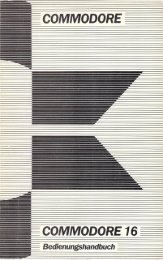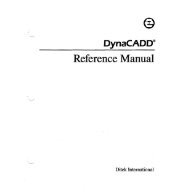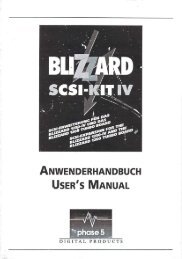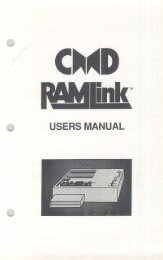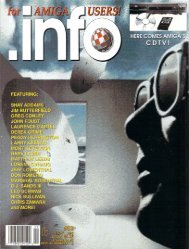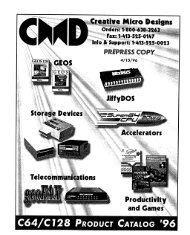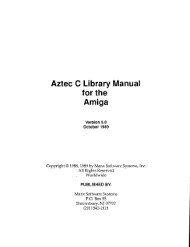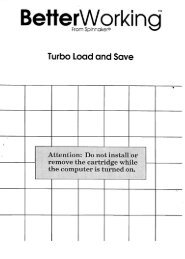Create successful ePaper yourself
Turn your PDF publications into a flip-book with our unique Google optimized e-Paper software.
Comparative Loading Tiroes<br />
for a 25K program.<br />
Datasette 666 Seconds<br />
1541 disk drive....78 Seconds<br />
1541 w/speed kit...28 Seconds<br />
Hard drive... ..1 Second<br />
...on a iff Megabyte drive,<br />
you could store "MONOPOLE"<br />
over ^30 times. This is<br />
eo.ua! to about GO disks."<br />
me read/write heart travels<br />
at speeds comparaDle to an<br />
airplane flying 600 m.p.n.<br />
at an altitude of 1/4 incn!<br />
The next media for storing data is the floppy<br />
disk. The disk is also made of plastic and<br />
covered with a iron-oxide material and enclosed<br />
in a sleeve. In many ways the storage of<br />
information is the same on a disk as it is on a<br />
tape. The advantages are that the disk may be<br />
rotated at very high speeds (300 rpm), and that<br />
the head can be moved to any point on the disk to<br />
read information. As a result, access time is<br />
greatly decreased. Yet, on the Commodore, the<br />
speed is still very slaw as the information is<br />
moving from the disk drive to the computer or<br />
from the computer to drive in serial format. Each<br />
character is made up of 8 bits. When this<br />
information is transferred in serial format, only<br />
one bit at a time is transferred to the computer.<br />
A parallel unit'urauld transfer this information<br />
as 8 bits, or one byte, at a time.<br />
Several companies have tried to create products<br />
to increase the rate of transfer of information<br />
to and from the disk drive. Some of these<br />
products include the 1541 Express from Richvale<br />
Telecommunications and the 1541 Flash from Skyles<br />
Electronics. Both units can increase the speed of<br />
data transfer by as much as 4 times.<br />
A good example of the differences in loading time<br />
is the 25K public domain program, 'Monopole1.<br />
With the Data Cassette, this program takes about<br />
11 minutes to load. On a standard 1541 Disk<br />
Drive, it takes a full 7D seconds and, using one<br />
of the speed up units that I mentioned, the time<br />
to load is about 20 seconds. On the new hard<br />
drive, 'Ptanopole1 will load in just ONE SECOND.<br />
Another nice feature of a hard drive is that the<br />
amount of memory is greatly increased. On a 1541<br />
Disk Drive, only six 25K programs can be stored<br />
on a single disk. However, on a 1D megabyte<br />
drive, you could store 'Monopole' over 390 times.<br />
This is equal to about 60 disks.<br />
The hard drive is much like a standard disk drive<br />
except that the disk is made out of aluminum<br />
instead of plastic. The read/write head, instead<br />
of resting right on the disk, floats on a cushion<br />
of air, 20 millionths of an inch above the disk.<br />
This air space is so small that a smoke particle<br />
can't begin to fit in the space between the disk<br />
and the head. (See figure 1) As a result, the<br />
hard drive must be sealed to prevent any type of<br />
contaminate to enter the drive.<br />
The disk in a hard drive also rotates at a much<br />
higher speed than a 1541. As the disk rotates at<br />
3600 rpm, the read/write head travels over the<br />
disk at speeds of over 100 miles an hour. This is<br />
comparable to an airplane flying 600 miles per<br />
hour around the circumference of a lake at an<br />
altitude of 1/4 inch. The high speed of both the<br />
drive and the read/write head increases the data<br />
transfer to and from the computer.<br />
Another major difference in a hard drive to a<br />
standard disk drive is that more than one disk<br />
and more than one read/write head will be found.<br />
The 10 megabyte drive that Roy and Lloyd are<br />
working on has 2 separate disks with 4 read/write<br />
heads to be able to read both sides of the disks.<br />
Larger drives of up to 80 megabytes will also be<br />
available.



